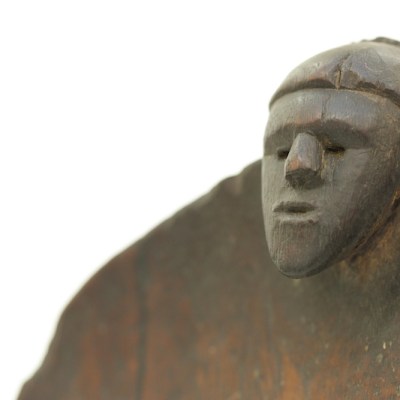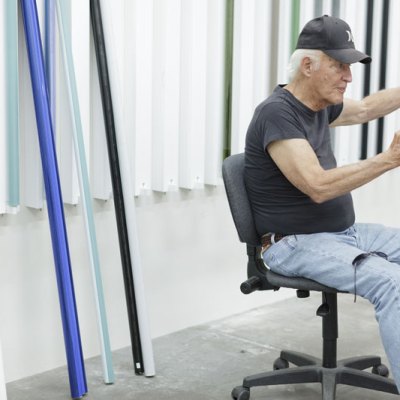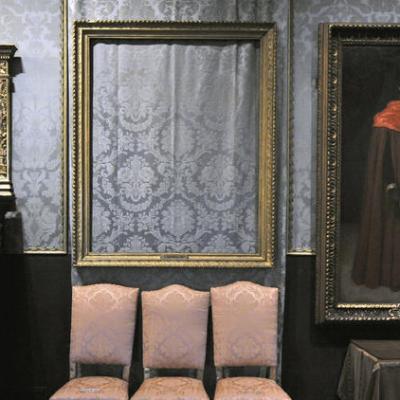If you stand outside the new Berlin exhibition space of German collector Julia Stoschek on the busy thoroughfare of Leipziger Strasse, one detail gleams out of the concrete modernist vista: a pristine white curtain. It shrouds the gallery’s large windows, and amid all the grey lines and rectangles of the area – once a showcase for GDR architecture – its bright chalk-white sculptural pleats catch your eye. The curtain also hints that this is not your average cavernous and luminous white cube. Inside is a warren of rooms with varying degrees of darkness, displaying 38 pieces from Stoschek’s vast collection of time-based media art.
The Julia Stoschek Collection’s temporary exhibition space in Berlin, opened in June 2016 in the former Czech cultural centre in the city’s Mitte district. Photo: Simon Vogel; courtesy Julia Stoschek Collection
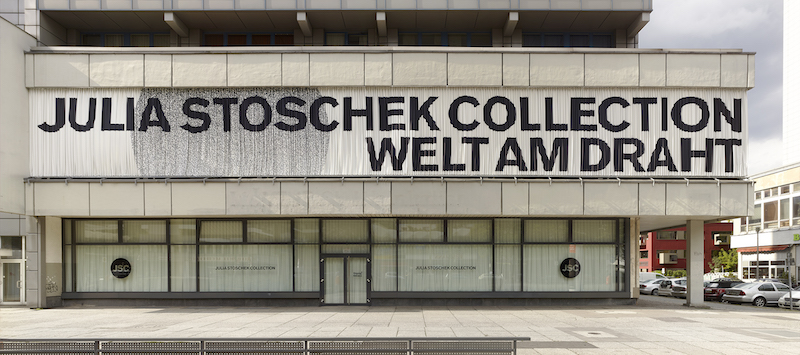
Stoschek’s collection currently numbers over 700 works by around 200 primarily European and US artists. This exhibition, titled ‘Welt am Draht’ (World on a Wire), draws on many of her latest acquisitions. It’s named after a 1973 Rainer Werner Fassbinder TV movie, a delirious, head-trip sci-fi epic about a cybernetics company which has created an alternative reality and populated it with ‘identity units’ who think they are human. Fassbinder wasn’t that familiar with computers when he made the film, but over 40 years on it still feels relevant, Stoschek explains. A lot of artists are influenced by him she thinks. ‘What makes it so special,’ Stoschek tells me of the exhibition, ‘is that most of the artists are born between 1982 and ’86. They are all post-internet artists. I know that this term is used a lot these days and some of the artists don’t like it. I think they create a totally new artistic language. Just compare them to Bruce Nauman or Vito Acconci. All the art pieces in the show deal with the existential questions of our daily lives since digitisation – what has changed about our reality and identity.’
Walking around the exhibition sometimes feels like stepping inside the chaotic wilderness of the internet. The space is teeming with surreal digital creations – some bleakly dystopic like Jon Rafman’s Betamale Trilogy – comprising deranged visions culled from the dark web, displayed in a glass cabin. Others, like Ian Cheng’s Emissary Forks at Perfection (2015), a virtually-animated live simulation projected rather spectacularly in an old cinema, resemble shape-shifting video games. In Cheng’s exuberantly-hued film, a dog and a dead 21st-century celebrity navigate a hellish post-ecological-disaster world where Darwinism rules. There are narrative strands in this opus exploring evolution but it is mostly, in Cheng’s words, ‘a video game that plays itself’. It’s infinite, meaning that a complete view of it, and by implication, the entire exhibition, is impossible. For Stoschek one avatar looms large: the computer-generated cadavers soliloquising about intimacy, love, representation and narcissism in Ed Atkins’ Us Dead Talk Love (2012). Atkins, who regularly muses on corporeality and who uses himself as the basis for his uncanny HD animations, is considered by Stoschek to be one of the most important post-internet artists; his work was the starting point for the show.
Installation view of Betamale Trilogy (Glass cabin), 2015, Jon Rafman (b. 1981). Photo: Simon Vogel; courtesy Julia Stoschek Collection; © Jon Rafman/Future Gallery, Berlin
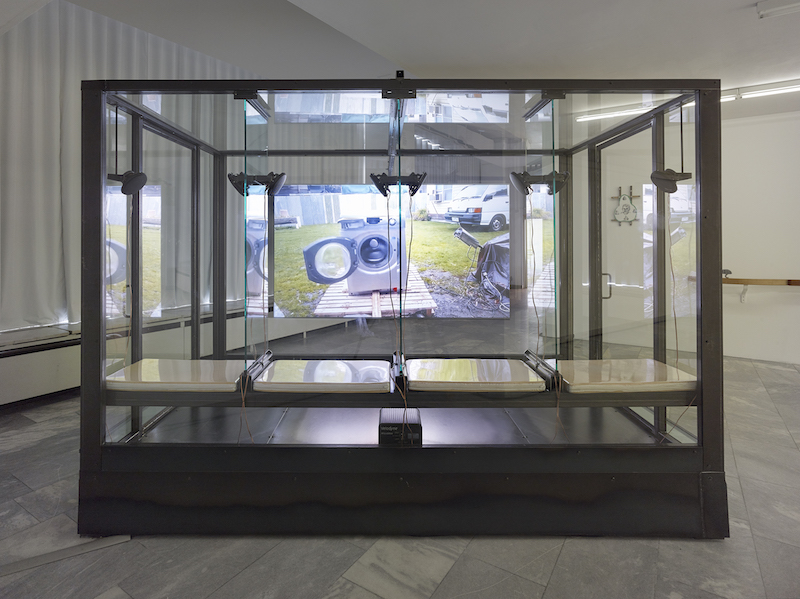
What strikes me as I wander around is how no two works are installed in the same way; every room looks different. Wu Tsang’s split-screen installation A day in the life of bliss (2014, which envisages a surveillance society where humans are controlled by a panoptical social media platform, uses mirrors to implicate the audience in her fiction. In an extra voyeuristic touch, one of them is a spy mirror. Meanwhile Melanie Gilligan’s multiscreen Netflix-esque mini-series The Common Sense (2014–15) set in a future world where people can experience the physical sensations and feelings of others, spreads across the space like a spider with its interconnecting screens joined by long metal legs. The curtain seen in the gallery’s window continues to blanket all the walls inside too, creating an immersive space that is dreamy and futuristic one moment and a sinister white labyrinth the next.
When I first meet Stoschek and the director of her collection, Monika Kerkmann, we are standing in front of the control centre of the second floor of the exhibition space. It’s a portable white board. Attached to it are nine different remote controls, each with a multitude of buttons. Every control is precisely labelled. It encapsulates one of the reasons why video art, since the medium emerged in the 1960s, has often been overlooked by collectors. ‘I think the technical side is something that a lot of people fear,’ Stoschek says. ‘But it’s not so difficult.’ Stoschek tells me that she is far from a technical expert herself but that she has never let that put her off. ‘Video art is collectable, but it needs a lot of effort, and not just financial effort. Time-based media has to be installed. Paintings or sculptures are easy to handle. Installing a two, three, four, five-channel installation involves much more work.’
Installation views of A day in the life of bliss, 2014, Wu Tsang (b. 1982). Photo: Simon Vogel; courtesy Julia Stoschek Collection; © Wu Tsang/Galerie Isabella Bortolozzi
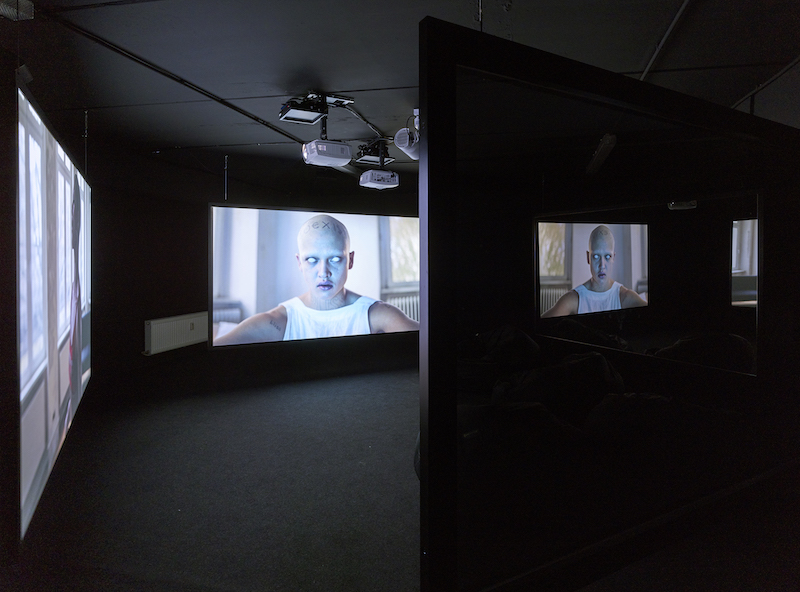
Moving-image art is a surprisingly fragile medium. In the 1990s the pioneering video-art-collecting couple, Pamela and Richard Kramlich, accidentally taped a news broadcast over a Dara Birnbaum video. Obsolescence is a recurring issue: many artists now are working with the latest digital technology; equipment has to be kept up to date. Stoschek’s entire collection is digitised but she always keeps art pieces in their original format, too, whether it’s Betacam tape or a 16mm film. The originals are stored in her climate-controlled archive.
Like photography, another medium that was marginalised for many years, most moving-image artworks are editions. ‘We do have some installations that are unique but this is very different to a painting collection. If you are focused on having just a unique art piece then this is not the right medium to collect.’ For Stoschek though, ‘It’s the contemporary language of our time. I would really like to create an image of the social and cultural changes of my generation. I’m focused on the here and now and the future. There is no biennale worldwide without a video piece. Most of the young artists use it. Ten years ago MoMA established a department for media and performance and now most museums have a department for it.’
Her collection is certainly diverse. It contains pieces by seminal artists like Bruce Nauman. But I spy she also has a Bjork music video (the 3D-fantasia Wanderlust). ‘I’m not interested in differentiating between a music video and a short movie and a video and a documentation of performance,’ she states. ‘We have art pieces that run for two or three hours with lots of narration; others for 20 seconds. I’m not interested in the boundaries.’
Installation view of The Common Sense (Phase 1, 5 episodes), 2014–15, Melanie Gilligan (b. 1979). Photo: Simon Vogel; courtesy Julia Stoschek Collection; © Melanie Gilligan/Galerie Max Mayer
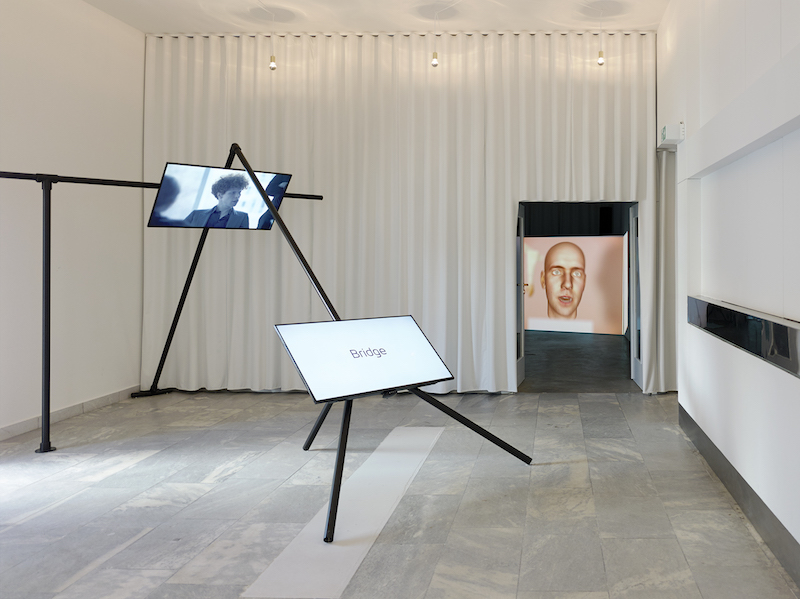
Unlike many collectors, for whom acquiring art is often a hereditary affair, Stoschek is the first in her family to do so. ‘Sometimes it’s very exciting to be an outsider,’ she says. Her grandfather founded a German auto-parts company. However her father, Michael Stoschek, who took over and expanded the company, had always wanted to be a photographer so there was a lot of technical equipment and video and photography cameras around her home when she was growing up. She was always interested in art so after studying business and economics it seemed natural to start a gallery. ‘But I was a very bad dealer,’ she says, and the gallery closed after three months. Instead she felt the need to participate in the process of making art, and started a project for artists-in-residence in Düsseldorf.
She credits German collector Harald Falckenberg with igniting her passion to collect, when she saw his collection in Hamburg in 2002. Surprisingly, given the focus of her collection, Stoschek’s first acquisition was a canvas by the Spanish artist Pep Agut. ‘But,’ she says, ‘it’s not just a painting, it’s a multimedia work.’
Another key encounter for her was with Douglas Gordon’s Play Dead; Real Time (2003). In Gordon’s monumental multiscreen installation his camera circles an Indian elephant as she responds to her trainer. It was filmed in the Gagosian’s New York exhibition space – and it was there that Stoschek saw it. ‘This was my first physical experience with time-based media. All of a sudden I realised that I had to follow my heart and concentrate on this new media.’
The first video piece she bought was by the American artist Aaron Young. ‘It’s called High Performance and it’s from 2001,’ Stoschek explains. ‘You see a motorcycle driver who’s doing 360-degree tyre “burnouts” in a studio space. In the beginning the driver is visible, but bit by bit he disappears in the smoke that the machine is producing. It’s somewhere between a sculpture and a painting and a video.’ While the collection doesn’t have an ethos, she says she tries to follow an artist over a period of time. ‘My understanding of collecting is not to have 100 different works from 100 artists. I want to have more than one or two pieces from each artist. And it sounds simple, but sometimes it’s really not – I try and acquire the masterpieces. I am not a name collector.’
The Julia Stoschek Collection in Dusseldorf . Courtesy Julia Stoschek Collection
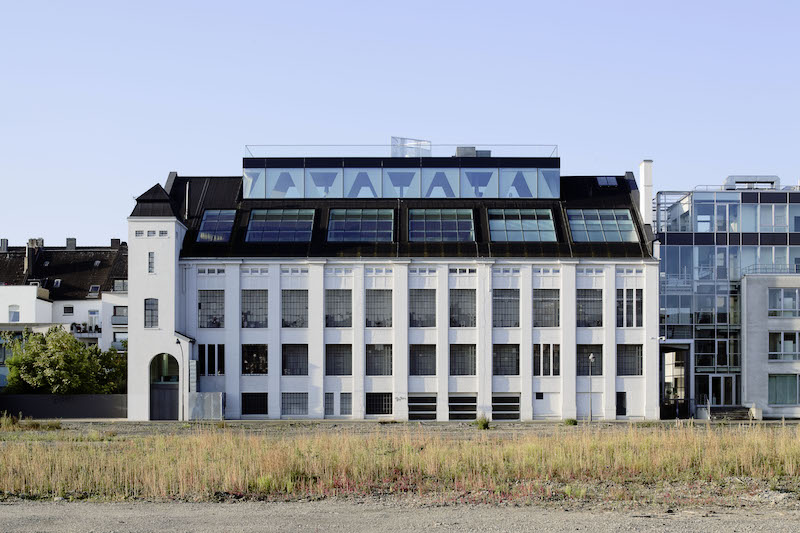
In 2007, due to her desire to share the collection and as a result of its rapid expansion, Stoschek converted a former factory in Düsseldorf into an exhibition space, complete with a cinema and an archive, and opened her collection to the public. What distinguishes Stoschek’s collection from others with a similar focus, like that of the Kramlichs or Ingvild Goetz (‘one of the pioneers concentrating on the medium,’ according to Stoschek), is her devotion to younger contemporary artists. But she stresses that historical works are also very important to her. Her exhibitions often find links between different generations of artists: Most recently, the show ‘Hello Boys’ linked feminist art from the 1970s and the work of female video artists and photographers today. She says that not much of her collection is installed at home but the video that inspired the title of that exhibition, a male-gaze-interrogating 1975 performance by Hannah Wilke, is one of the few pieces she has in her Berlin apartment.
Which work in the collection was the most difficult to acquire I ask? A piece by Francis Alÿs, she says: ‘He’s a remarkable artist. I fell in love with Rehearsal I (1999–2001). A VW Beetle is climbing up a hill in Mexico but never gets to the top and keeps running back down. It’s a symbol for the modern Sisyphus, and also the desperate situation of Latin America, especially Mexico. I think it is his masterpiece. I had to wait seven years to acquire it for the collection.’ There are also works that remain elusive, like Matthew Barney’s Cremaster series – ‘one of the most important media art pieces ever produced,’ Stoschek believes. ‘But they were sold out long before I started collecting. But if it is installed anywhere I would travel there. It’s most appropriate if these works are in public institutions, then more people have the opportunity to experience them.’
With the exhibition roster at her two galleries as well as the publications, events, and film programme that accompany them, there is very little to distinguish her space from a public museum. One of the main differences is that a private collection can be more flexible; they don’t plan five to ten years ahead. However she says it was very important for her not to compete with public institutions: ‘I always love collaborating with other institutions. I love when the collection goes abroad. We’ve been to museums in Stockholm, Tel Aviv, Budapest, Kiev, and Hamburg. I have donated quite important art pieces to institutions [among them Interiors (2002) by Doug Aitken to MOMA]. It is my understanding that private and public institutions have to work well together.’
Berlin is home to several significant private collections of contemporary art which are open to the public (albeit in a much more limited fashion): among them the Sammlung Boros in a concrete bunker; the Haubrok Collection in a former GDR-government car compound and the Hoffmann Collection in an old factory. Why did Stoschek decide to open her second gallery in the city? ‘Most of the artists in Germany who are represented in the collection live there. Berlin is also the city of the start-up. I think it’s interesting to have a space for media art here.’
Installation view of Palisades in Palisades, 2015, Rachel Rose (b. 1986). Photo: Simon Vogel; courtesy Julia Stoschek Collection; © Rachel Rose/Pilar Corrias Gallery, London and Gavin Brown’s enterprise, New York

The search for the right building took over a year. ‘Berlin is full of landmark buildings as well as empty and historical spaces. In Düsseldorf, we have an old industrial building from 1907. It’s perfect for the purposes of my collection. For me it was important to reinvent the architectural concept of Düsseldorf – this means not to have a bunker or a water tower or a factory here. What I love so much about this space is that it is typical GDR “Plattenbau” architecture. I love the view over Leipziger Strasse; this brutal, rough architecture. But it’s such an elegant space, too.’ However it wasn’t when they first moved in: ‘It was very chaotic. We had three weeks to clean it up and transform it from a former culture centre, which had been used as a nightclub, into an exhibition space.’
Stoschek and Kerkmann selected the young German architect Johanna Meyer-Grohbrügge to redesign the building’s interior. Previously Meyer-Grohbrügge had worked for Tokyo architects SANAA and you can see the influence of their ethereal, white architecture. ‘Inside,’ Stoschek says of the white curtain that was Meyer-Grohbrügge’s idea, ‘it generates a totally new kind of exhibition space. I also like how a curtain underlines the private character of a private collection.’
When I ask Stoschek which young artists she is particularly excited about, she reels off a long list: ‘Helen Marten is someone I’m very interested in, Anicka Yi, Loretta Fahrenholz, Hannah Black, Rachel Rose and Ian Cheng – Emissary Forks at Perfection is one part of a trilogy.’ How does she discover them? ‘I travel and talk to a lot of people. In general, I would say that the dialogues with artists and curators are the most inspiring moments for bringing artworks to my attention. However, there is a difference between somebody bringing something to your attention, and actually acquiring an artwork. For that to happen, I still need a connection to that work based on my subjective and personal encounter with it.’ During the interview, Stoschek borrows a pen from me and makes a note of the shows she and Kerkmann will visit when they go to Kassel shortly. Finding new art and artists is not difficult: ‘The problem is how to sort and filter. So much art gets offered to me.’
The future for Stoschek then – who gave birth to her first child four months ago, just before the Berlin exhibition space opened – looks busy. There will be a 10th anniversary show in their Düsseldorf space next year. She is also very excited about mounting a solo exhibition of Turner Prize-winning British video-collagist Mark Leckey. The Berlin gallery was originally a temporary satellite but they will now stay there for at least two years. I ask her if she would ever want to build her own exhibition space from scratch. Her eyes light up: ‘You could rethink how people watch video art. You could create a building that is really appropriate to the medium. I imagine a space like a tower.’
From the October issue of Apollo: preview and subscribe here

